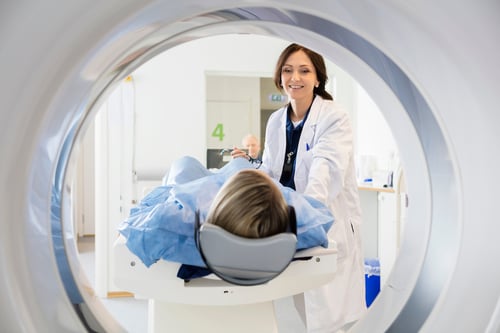Lung Cancer Detection & Diagnosis
Free Guide for Newly Diagnosed Lung Cancer Patients
Tests For Lung Cancer
Many tests are used to detect, diagnose, and even stage lung cancer. Tests are also used to learn if cancer has spread (metastasized) to another part of the body from where it started.
For most types of cancer, a biopsy is the only sure way for your doctor to know if an area of the body has cancer. In a biopsy, your doctor takes a small sample of tissue for testing in a laboratory. If a biopsy is not possible, he or she may suggest other tests that will help make a diagnosis.
Your doctor may consider these factors when choosing a diagnostic test:
- Size, location, and type of cancer suspected
- Your signs and symptoms
- Your age and general health
- The results of earlier medical tests
In addition to a physical examination and discussion about your family health history, the following tests may be used to diagnose and stage both small cell lung cancer (SCLC) and non-small cell lung cancer (NSCLC).
Tests to Find Lung Cancer
- Chest x-ray. Your physician will order an x-ray of the organs and bones inside the chest.
- CT Scan (CAT scan) of the brain, chest, and abdomen. This is a series of detailed pictures of areas inside the body, taken from different angles. The pictures are made by a computer linked to an x-ray machine. A dye may be injected into a vein or swallowed to help the organs or tissues show more clearly. This procedure is also called computed tomography, computerized tomography, or computerized axial tomography.
- MRI (magnetic resonance imaging). An MRI is a procedure that uses a magnet, radio waves, and a computer to make a series of detailed pictures of areas inside the body, such as the brain. This procedure is also called nuclear magnetic resonance imaging (NMRI).
- PET Scan (positron emission tomography scan). For a PET scan, a small amount of radioactive glucose (sugar) is injected into a vein, which aims to find malignant tumor cells in the body. The PET scanner rotates around the body and makes a picture of where glucose is being used in the body. Malignant tumor cells show up brighter in the picture because they are more active and take up more glucose than normal cells do.
- Radionuclide bone scan. This procedure is used to check if there are rapidly dividing cells, such as cancer cells, in the bone. A very small amount of radioactive material is injected into a vein and travels through the bloodstream, where it collects in the bones and is detected by a scanner.
Tests to Diagnose Lung Cancer
- Fine-needle aspiration (FNA) biopsy of the lung. First, a CT scan, ultrasound, or other imaging procedure is used to locate the abnormal tissue or fluid in the lung, and then a small incision may be made in the skin where the biopsy needle is inserted into the abnormal tissue or fluid. A sample is removed with the needle and sent to the laboratory. A pathologist then views the sample under a microscope to look for cancer cells. A chest x-ray is performed afterward to ensure that no air is leaking from the lung into the chest.
- Thoracentesis. This test uses a needle to remove fluid from the space between the lining of the chest and the lung. A pathologist then views the fluid under a microscope to look for cancer cells.
- Sputum Cytology. In this test, a microscope is used to check for cancer cells in the sputum (mucus coughed up from the lungs).
Molecular Testing for Non-Small Cell Lung Cancer
Genetic testing is performed on the tissue removed during the biopsy or surgery to determine if there are any genetic mutations that can be treated with targeted therapy.
Learn more about biomarker testing for non-small cell lung cancer.
PD-L1 testing on tumor cells is also performed to determine whether there is too much of this protein present. If so, immunotherapy may be added to block its production and slow the growth of cancer cells.
Tests to Determine the Extent of Lung Cancer
This is also referred to as staging and may be requested during your first appointment with the oncologist who will treat the cancer.
- Bronchoscopy. This test uses a bronchoscope, which is a thin, tube-like instrument with a light and a lens for viewing, that is inserted through the nose or mouth into the trachea and lungs to look inside the trachea and large airways in the lung for abnormal areas. A bronchoscope may also have a tool to remove tissue samples, which are checked under a microscope for signs of cancer.
- Thoracoscopy. This is a surgical procedure that checks for abnormal areas by looking at the organs inside the chest. A thoracoscope is a thin, tube-like instrument with a light and a lens for viewing. Typically, an incision (cut) is made between two ribs to insert a thoracoscope into the chest for viewing or for using a tool to remove tissue or lymph node samples that are then checked under a microscope for signs of cancer. In some cases, this procedure is used to remove part of the esophagus or lung. If certain tissues, organs, or lymph nodes can’t be reached, a thoracotomy may involve a larger incision between the ribs to open the chest.
- Endoscopic ultrasound (EUS). This is a procedure in which an endoscope is inserted into the body. A probe at the end of the endoscope is used to bounce high-energy sound waves (ultrasound) off internal tissues or organs and make echoes. The echoes form a picture of body tissues called a sonogram. This procedure is also called endosonography. EUS may be used to guide fine needle aspiration (FNA) biopsy of the lung, lymph nodes, or other areas.
Lab Tests
Your lab tests include testing samples of tissue, blood, urine, or other substances in the body. These tests help to diagnose disease, plan and check treatment, or monitor the disease over time.
Lung Function Tests
Lung function tests (PFTs) are performed after a lung cancer diagnosis to see how well your lungs are working. If surgery is part of the treatment plan, these tests will let the surgeon and oncologist know how well you're breathing before removing part or all of a lung.
Most PFTs require you to breathe in and out through a tube that is connected to a machine that measures airflow.
Leading Edge Care in Colorado When Lung Cancer is Diagnosed
At Rocky Mountain Cancer Centers, we understand that a diagnosis of lung cancer can be overwhelming. This is why our friendly and compassionate specialists are dedicated to delivering personalized care in a supportive environment. Together, we will fight lung cancer.



